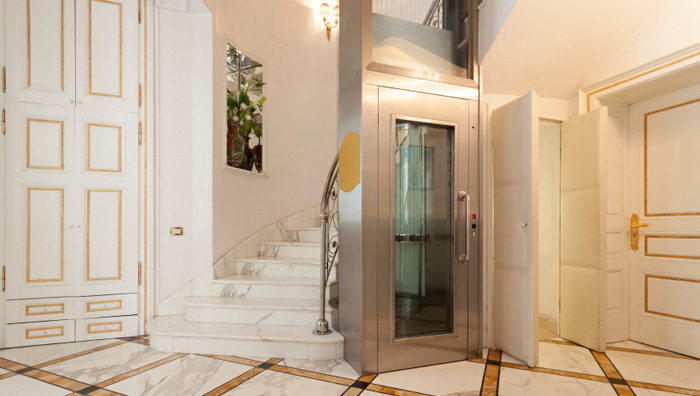When you install a residential elevator in your multi-story home, you’re investing in both convenience and accessibility. However, as with any mechanical system, safety is a top priority. Modern home elevators are equipped with a range of safety features designed to ensure smooth operation, minimize risks, and protect users. From emergency stop buttons to backup power systems, these features help make elevators a safe and reliable addition to any home. Here’s a closer look at the essential safety mechanisms in residential elevators that you should know about.

Emergency Stop Button
One of the most critical safety features in any elevator is the emergency stop button. Located inside the elevator car, this button allows users to halt the elevator’s movement instantly in case of an emergency. Whether there’s a mechanical malfunction, an unexpected obstruction, or an issue with the passengers inside, the emergency stop button provides a fail-safe to ensure the elevator ceases operation immediately.
While the elevator’s movement will stop when the button is pressed, it’s important to note that this is intended for use in emergency situations only. Frequent or unnecessary use of the emergency stop can lead to mechanical issues or disrupt the elevator’s normal operation. For routine situations, it’s better to use the standard controls or contact a technician for any problems.
Door Sensors
Elevator doors are a critical area when it comes to safety. Modern residential elevators are equipped with door sensors that detect obstructions, preventing the doors from closing if something is in the way. This is especially useful in homes with children, pets, or people who may inadvertently block the doorway while entering or exiting the elevator.
Most door sensors operate using infrared beams or pressure-sensitive mechanisms that can detect if an object is obstructing the path of the doors. If the sensor detects an obstruction, the doors will either stop closing or automatically open to allow the obstruction to clear. This feature significantly reduces the risk of injury or damage to both people and the elevator system.
Backup Power Systems
Home elevators are typically powered by electricity, but like any electrical appliance, they can be susceptible to power outages. To mitigate the risk of being stuck between floors during a power failure, many residential elevators come equipped with a backup power system. This system ensures that, in the event of a power outage, the elevator will continue to operate long enough to return to the nearest floor safely.
Backup power systems generally rely on batteries or a manual backup system that can lower the elevator to a safe position. Some elevators also have a mechanical bypass that allows the car to descend slowly to the ground floor in case of an emergency, giving you peace of mind even in the event of a complete power failure.
Overload Sensors
Overloading an elevator can cause significant damage to both the system and the people using it. Modern home elevators are equipped with overload sensors that detect when the weight in the elevator exceeds the rated capacity. When the system detects an overload, it will prevent the elevator from operating and issue a warning, often through a visual indicator or an alarm.
This feature is essential in preventing strain on the motor, cables, and other critical components of the elevator, which could lead to costly repairs or even safety risks. Educating family members and visitors about the weight limit of your elevator and ensuring that they do not exceed it can help maintain the system’s integrity and longevity.
Emergency Communication System
In case of an emergency, an elevator should provide a way for passengers to communicate with someone outside the elevator, especially if they are trapped. Many modern residential elevators are equipped with an emergency communication system. This may include a telephone, intercom, or two-way communication device that allows the user to contact a designated person or a professional elevator technician.
In the event of a malfunction, an emergency communication system ensures that help is never far away, providing peace of mind for all residents and users of the elevator.
Safety Brakes and Overspeed Governors
Residential elevators are equipped with safety brakes and overspeed governors to prevent the elevator from moving too quickly or uncontrollably. The overspeed governor detects excessive speed and automatically engages the brakes to slow the elevator down and stop it, preventing any sudden falls or malfunctions.
The safety brakes are designed to hold the elevator car in place, even if the system experiences a mechanical failure. This is particularly important if there’s an issue with the elevator’s drive system, as the safety brakes ensure that the car doesn’t descend uncontrollably.
Automatic Leveling Mechanism
An automatic leveling mechanism ensures that the elevator car always stops at the correct floor level. This prevents the risk of the elevator being slightly above or below the landing, which could cause accidents when passengers attempt to enter or exit the car. The leveling system ensures that the car aligns perfectly with the floor every time, providing a smooth and safe transition.
Safety First!
Installing a residential elevator in your home adds not only luxury and convenience but also essential safety features that help protect you and your loved ones. From emergency stop buttons and door sensors to backup power systems and overload protection, these features are specifically designed to minimize risks and ensure the smooth operation of your elevator. By familiarizing yourself with these mechanisms and regularly maintaining the system, you can enjoy the benefits of your elevator with confidence, knowing that safety is built into every ride.
